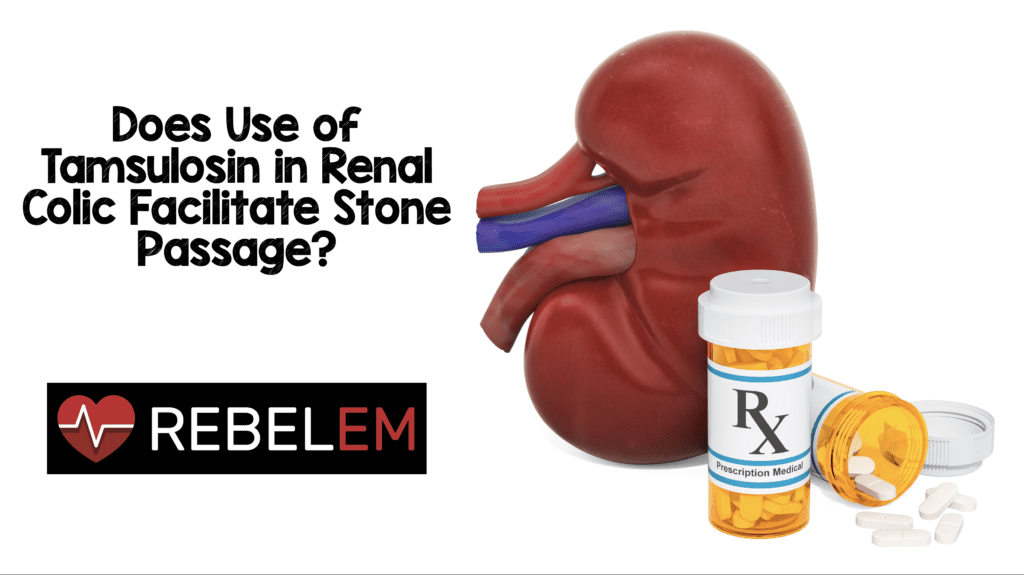
 Renal colic is a common ED presentation. Rarely does a day go by that we don’t see a patient rocking and rolling in acute renal colic. Dan Firestone makes an impassioned argument against the use of CT scanning for diagnosis of renal colic so I won’t address that here. Once we make a diagnosis, our primary goal in the ED is pain relief. Then we turn our attention to disposition planning, follow up and outpatient medications. The majority (90%) of stones will pass spontaneously but it would be nice if we could:
Renal colic is a common ED presentation. Rarely does a day go by that we don’t see a patient rocking and rolling in acute renal colic. Dan Firestone makes an impassioned argument against the use of CT scanning for diagnosis of renal colic so I won’t address that here. Once we make a diagnosis, our primary goal in the ED is pain relief. Then we turn our attention to disposition planning, follow up and outpatient medications. The majority (90%) of stones will pass spontaneously but it would be nice if we could:
- increase the passage rate
- shorten the time to passage.
This could potentially reduce ED revisits, reduce the number of invasive procedures and make happy patients. So does the use of tamsulosin in renal colic facilitate stone passage?
What Urban Legend Will we Cover Today?
Patients with ANY ureteral stone should be treated with alpha antagonists to facilitate stone passage.
What is the background for the use of alpha antagonists in renal expulsion therapy?
The pathophysiologic basis for this treatment is that alpha antagonists inhibit contraction of ureteral muscles responsible for ureterospasm allowing for an increased rate of stone propagation. Alpha 1-adrenergic receptors are concentrated in the distal ureter and as a result, it is distal stones that that should theoretically benefit most. Many urologists (at least in the US) recommend treatment with these agents and tamsulosin is the preferred treatment because it carries a lower side effect profile.
The idea of medical expulsion therapy seems to have entered the EM realm after the publication of a systematic review in Annals of Emergency Medicine in 2007 [1]. This review concluded that the results
“are encouraging for the use of an alpha-antagonist or calcium channel blocker to facilitate stone expulsion of moderately sized distal ureteral calculi; however, because of the limitation of methodologic quality with the studies reviewed, a large, well-done, randomized clinical trial is needed to confirm these results before uniform adoption can be recommended.”
The caveat at the end of their conclusions is vital but appears to have been initially glossed over by many providers (myself included). The reason for this disclaimer was that the quality of the studies they were able to find was poor: randomization, blinding and follow-up were all markedly sub-optimal.
This is a great example of systematic reviews and meta-analyses only being as good as the original studies that go into them. I always use the haircut analogy. I wouldn’t let a 5 year-old cut my hair. I also wouldn’t let five 5 year-olds cut my hair because five 5 year-olds don’t make a 25 year-old. Putting together a bunch of poor studies does not make a good study.
Despite these limitations, this study appears to have changed practice. Now, though, we have better evidence to guide our decisions.
What other studies have evaluated the use of alpha antagonists to facilitate stone passage?
 Al-Ansari et al. Efficacy of Tamsulosin in the Management of Lower Ureteral Stones: A Randomized Double-blind Placebo-controlled Study of 100 Patients. Urology 2010; 75: 4-8. [2]
Al-Ansari et al. Efficacy of Tamsulosin in the Management of Lower Ureteral Stones: A Randomized Double-blind Placebo-controlled Study of 100 Patients. Urology 2010; 75: 4-8. [2]
Details
- RDCT of 100 patients
- Overall stone expulsion 82% vs. 61% giving a RR = 2.93 for tamsulosin
- Stones < 5 mm benefited more
- Shorter time to expulsion and less pain medication use
Limitations + Problems
- It’s unclear if these were Emergency Department patients.
- It’s unclear what the primary outcome is.
- Patients discharged on parenteral diclofenac (not standard care for us)
This is the only randomized trial to show a benefit to tamsulosin but there are some major issues. The passage rate for stones < 5 mm is considerably lower in the placebo group (69%) than what has been typically described (Segura 1997). Additionally, the authors do not make it clear what the primary outcome was meant to be. It is possible that a number of outcomes were assessed and the ones that were statistically significant were reported.
 Hermanns T et al. Is There a Role for Tamsulosin in the Treatment of Distal Ureteral Stones of 7 mm or less? Results of Randomised, Double-Blind, Placebo-Controlled Trial. European Urology 2009; 407-12. [3]
Hermanns T et al. Is There a Role for Tamsulosin in the Treatment of Distal Ureteral Stones of 7 mm or less? Results of Randomised, Double-Blind, Placebo-Controlled Trial. European Urology 2009; 407-12. [3]
Details
- RDCT of 100 patients
- Primary endpoint – stone passage @ 21 days – 86.7% vs. 88.9% (non-significant difference)
- Secondary endpoint – time to passage and pain medication use (non-significant difference)
Limitations + Problems
- Time to passage data missing for 1/3 of patients
- Outpatient study
- Majority of stones < 5 mm
 Ferre RM et al. Tamsulosin for Ureteral Stones in the ED: a Randomized, Controlled Trial. Ann of EM 2009; 54: 432-9. [4]
Ferre RM et al. Tamsulosin for Ureteral Stones in the ED: a Randomized, Controlled Trial. Ann of EM 2009; 54: 432-9. [4]
Details
- RCT in the Emergency Department of 80 patients
- Primary outcome – stone passage @ 14 days – 77.1% vs 64.9% (non-significant difference)
- Secondary outcomes – time to passage, pain scores, renal colic episodes, return visits to the ED (no significant differences)
Limitations + Problems
- No placebo and no blinding (this tends to favor the drug, though).
- Mean stone size was small (3.6 mm)
 Vincendeau S et al. Tamsulosin hydrochloride vs Placebo for Management of Distal Ureteral Stones. Arch Intern Med 2010; 170(22): 2021-7. [5]
Vincendeau S et al. Tamsulosin hydrochloride vs Placebo for Management of Distal Ureteral Stones. Arch Intern Med 2010; 170(22): 2021-7. [5]
Details
- RDCT in the Emergency Department of 129 patients
- Primary outcome – time to expulsion – no statistically significant difference
- Secondary outcome – passage at 42 days – non-significant difference
Limitations + Problems
- Patients all admitted to urology
Summary of the above studies: Clearly, there is disagreement in the literature. None of the studies are ideal. We continue to lack a large, RDCT done on patients presenting to the Emergency Department with renal colic.

Clinical Bottom Line:
The best evidence we have to date, does not show a significant benefit in the use of tamsulosin in renal colic to facilitate stone passage.
References:
- Singh A et al. A Systematic Review of Medical Therapy to Facilitate Passage of Ureteral Calculi. Ann Emerg Med 2007. PMID: 17681643
- Al-Ansari A et al. Efficacy of Tamsulosin in the Management of Lower Ureteral Stones: A Randomized Double-Blind Placebo-Controlled Study of 100 Patients. Urology 2010. PMID: 20109697
- Hermanns T et al. Is There a Role for Tamsulosin in the Treatment of Distal Ureteral Stones of 7mm or Less? Results of a Randomised, Double-Blind, Placebo-Controlled Trial. Our Urol 2009. PMID: 19375849
- Ferre RM et al. Tamsulosin for Ureteral Stones in the Emergency Department: A Randomized, Controlled Trial. Ann Emerg Med 2009. PMID: 19200622
- Vincendeau S et al. Tamsulosin Hydrochloride vs Placebo for Management of Distal Ureteral Stones: A Multicentric, Randomized, Double-Blind Trial. Arch Intern Med 2010. PMID: 21149761
For More on This Topic checkout:
- Ken Milne over at The Skeptics Guide to Emergency Medicine (The SGEM): SGEM#71 – Like a Rolling Kidney Stone (A Systematic Review of Renal Colic)
- Ureteral Stones Clinical Guidelines Panel summary report on the management of ureteral calculi. J Urol. 1997
- Ryan Radecki at Emergency Literature of Note: Finally, an End to Tamsulosin for Renal Colic?
The post Does Use of Tamsulosin in Renal Colic Facilitate Stone Passage? appeared first on REBEL EM - Emergency Medicine Blog.
